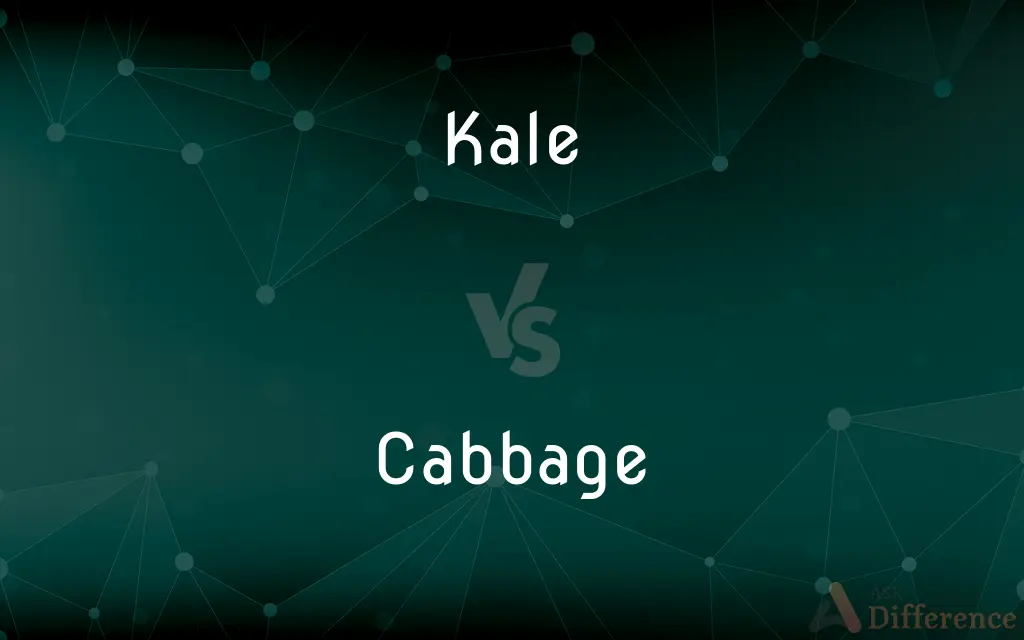Kale vs. Cabbage — What's the Difference?
Edited by Tayyaba Rehman — By Urooj Arif — Updated on April 7, 2024
Kale is a dark, leafy green known for its high nutrient content, while cabbage is a lighter, crunchy vegetable often used in salads and coleslaws.

Difference Between Kale and Cabbage
Table of Contents
ADVERTISEMENT
Key Differences
Kale is celebrated for its nutritional benefits, packed with vitamins, minerals, and antioxidants. It has a slightly bitter taste and is often used in salads, smoothies, and as a cooked side dish. On the other hand, cabbage, with its softer texture and milder flavor, is versatile in culinary uses ranging from raw in salads to fermented dishes like sauerkraut.
While kale thrives in cooler temperatures, making it available in the fall and winter, cabbage is more adaptable to a variety of climates, which allows for a broader growing season. This difference in availability can influence their use in seasonal dishes and cuisines.
Kale leaves are tougher and more fibrous, requiring massaging or cooking to soften, which enhances its flavor and digestibility. Conversely, cabbage, particularly the softer varieties like Savoy, can be more easily integrated into dishes raw, retaining its texture and nutrients.
Kale varieties, such as curly kale, dinosaur kale, and red Russian kale, offer a range of textures and flavors, making them a versatile ingredient for culinary experimentation. Cabbage, however, with its types including green, red, and Napa, provides a spectrum of tastes and uses, from fresh salads to slow-cooked meals.
In terms of health benefits, kale stands out for its higher concentration of vitamins A, C, and K, along with antioxidants like quercetin and kaempferol. Cabbage, while also nutritious, is renowned for its high vitamin C content and benefits from fermentation, which can enhance its probiotic properties.
ADVERTISEMENT
Comparison Chart
Nutrient Density
Higher in vitamins A, C, K, and minerals
High in vitamin C, but less nutrient-dense than kale
Flavor
Slightly bitter, stronger taste
Milder, sweeter taste
Texture
Tough, fibrous leaves
Softer, crunchier leaves
Culinary Uses
Salads, smoothies, cooked dishes
Raw in salads, fermented, cooked dishes
Health Benefits
Rich in antioxidants, anti-inflammatory
High in vitamin C, beneficial for gut health when fermented
Compare with Definitions
Kale
A staple in healthy eating and vegetarian diets.
Kale chips are a tasty, healthy snack option.
Cabbage
Versatile in culinary uses, both raw and cooked.
Cabbage rolls are a comforting, hearty meal.
Kale
Leafy green vegetable used in a variety of dishes.
We added kale to the soup for extra nutrients.
Cabbage
Known for its high vitamin C content.
Eating cabbage can help boost your immune system.
Kale
A type of cabbage with green or purple leaves, known for its nutritional value.
Kale has become popular in smoothies for its health benefits.
Cabbage
A plant with thick green or purple leaves, used as a vegetable.
Cabbage is often used in salads and coleslaw.
Kale
Known for its high content of vitamins and minerals.
Kale is a great source of vitamin C and iron.
Cabbage
Can be fermented to make sauerkraut.
We started fermenting cabbage to make homemade sauerkraut.
Kale
Can be eaten raw or cooked.
I prefer my kale massaged with a bit of olive oil before adding it to salads.
Cabbage
Common ingredient in various dishes, from salads to soups.
Shredded cabbage adds crunch to this noodle dish.
Kale
Kale (), or leaf cabbage, belongs to a group of cabbage (Brassica oleracea) cultivars grown for their edible leaves, although some are used as ornamentals. Kale plants have green or purple leaves, and the central leaves do not form a head (as with headed cabbage).
Cabbage
Cabbage (comprising several cultivars of Brassica oleracea) is a leafy green, red (purple), or white (pale green) biennial plant grown as an annual vegetable crop for its dense-leaved heads. It is descended from the wild cabbage (B. oleracea var.
Kale
A hardy cabbage of a variety which produces erect stems with large leaves and no compact head.
Cabbage
Any of several forms of a vegetable (Brassica oleracea var. capitata) of the mustard family, having a globose head consisting of a short stem and tightly overlapping green to purplish leaves.
Kale
Money.
Cabbage
Any of several similar or related plants, such as Chinese cabbage.
Kale
A plant (Brassica oleracea var. acephala) in the mustard family, having dark green, spreading, usually crinkled leaves that are eaten as a vegetable. Also called borecole, cole, colewort.
Cabbage
The terminal bud of several species of palm, eaten as a vegetable.
Kale
(Slang) Money.
Cabbage
(Slang) Money, especially in the form of bills.
Kale
An edible plant, similar to cabbage, with curled leaves that do not form a dense head (Brassica oleracea var. acephala)
Cabbage
(Informal) Sweetheart; dear. Used as a term of endearment.
Kale
Any of several cabbage-like food plants that are kinds of Brassica oleracea.
Cabbage
An edible plant (Brassica oleracea var. capitata) having a head of green leaves.
Kale
(cooking) Broth containing kale as a chief ingredient.
Cabbage
(uncountable) The leaves of this plant eaten as a vegetable.
Cabbage is good for you.
Kale
Money.
Cabbage
A person with severely reduced mental capacities due to brain damage.
After the car crash, he became a cabbage.
Kale
A variety of cabbage in which the leaves do not form a head, being nearly the original or wild form of the species.
Cabbage
Used as a term of endearment.
Kale
See Kail, 2.
Cabbage
Money.
Kale
Informal terms for money
Cabbage
Marijuana leaf, the part that is not smoked but from which cannabutter can be extracted.
Kale
A hardy cabbage with coarse curly leaves that do not form a head
Cabbage
The terminal bud of certain palm trees, used for food.
Kale
Coarse curly-leafed cabbage
Cabbage
The cabbage palmetto (Sabal palmetto), a palm of the southeastern US coasts and nearby islands.
Cabbage
Leftover scraps of fabric.
Cabbage
Scraps of cloth which are left after a garment has been cut out, which tailors traditionally kept.
Cabbage
(intransitive) To form a head like that of the cabbage.
To make lettuce cabbage
Cabbage
To do nothing; to idle; veg out.
Cabbage
(transitive) To purloin or embezzle; to pilfer, to steal.
Cabbage
An esculent vegetable of many varieties, derived from the wild Brassica oleracea of Europe. The common cabbage has a compact head of leaves. The cauliflower, Brussels sprouts, etc., are sometimes classed as cabbages.
Cabbage
The terminal bud of certain palm trees, used, like, cabbage, for food. See Cabbage tree, below.
Cabbage
The cabbage palmetto. See below.
Cabbage
Cloth or clippings cabbaged or purloined by one who cuts out garments.
Cabbage
To form a head like that the cabbage; as, to make lettuce cabbage.
Cabbage
To purloin or embezzle, as the pieces of cloth remaining after cutting out a garment; to pilfer.
Your tailor . . . cabbages whole yards of cloth.
Cabbage
Any of various types of cabbage
Cabbage
Informal terms for money
Cabbage
Any of various cultivars of the genus Brassica oleracea grown for their edible leaves or flowers
Cabbage
Make off with belongings of others
Common Curiosities
Which is better for smoothies, kale or cabbage?
Kale is more commonly used in smoothies due to its nutrient density and ability to blend well with other flavors.
Are kale and cabbage from the same family?
Yes, both kale and cabbage belong to the Brassica family, known for cruciferous vegetables.
What's the main nutritional difference between kale and cabbage?
Kale is higher in vitamins A, C, and K, while cabbage is rich in vitamin C but less nutrient-dense.
Can eating cabbage improve gut health?
Yes, especially when fermented as sauerkraut, cabbage can improve gut health due to its probiotic properties.
How do you soften kale for salads?
Massaging kale leaves with a bit of oil and salt can soften them and make them more palatable for salads.
How long does kale last in the fridge?
Kale can last up to a week in the fridge when stored properly in a plastic bag.
Can kale and cabbage be used interchangeably in recipes?
While they can sometimes be substituted for each other, their different textures and flavors may alter the dish's outcome.
Is cabbage good for weight loss?
Cabbage is low in calories and high in fiber, making it a great addition to a weight loss diet.
Is it necessary to remove the stems from kale before eating?
Yes, kale stems are tough and fibrous, so it's recommended to remove them before eating or cooking the leaves.
What are the health benefits of kale?
Kale is known for its anti-inflammatory properties, high antioxidant content, and benefits to heart health.
Is cabbage cheaper than kale?
Generally, cabbage is more affordable than kale, though prices can vary by location and season.
Can cabbage be eaten raw?
Yes, cabbage is often eaten raw in salads and coleslaws for its crunchy texture.
What makes kale bitter?
Kale's bitterness is attributed to its high levels of certain antioxidants and compounds beneficial to health.
How do you reduce the bitterness of kale?
Cooking or massaging kale with a bit of lemon juice or vinegar can help reduce its bitterness.
What are the best ways to cook kale?
Steaming, sautéing, or baking (as in kale chips) are popular ways to cook kale.
Share Your Discovery

Previous Comparison
Rate vs. Level
Next Comparison
Set vs. PutAuthor Spotlight
Written by
Urooj ArifUrooj is a skilled content writer at Ask Difference, known for her exceptional ability to simplify complex topics into engaging and informative content. With a passion for research and a flair for clear, concise writing, she consistently delivers articles that resonate with our diverse audience.
Edited by
Tayyaba RehmanTayyaba Rehman is a distinguished writer, currently serving as a primary contributor to askdifference.com. As a researcher in semantics and etymology, Tayyaba's passion for the complexity of languages and their distinctions has found a perfect home on the platform. Tayyaba delves into the intricacies of language, distinguishing between commonly confused words and phrases, thereby providing clarity for readers worldwide.
















































